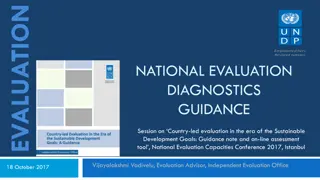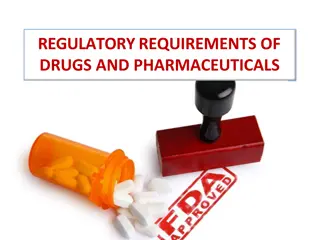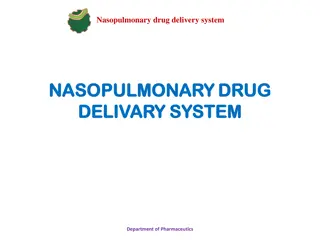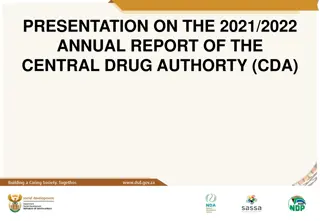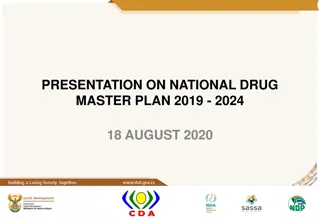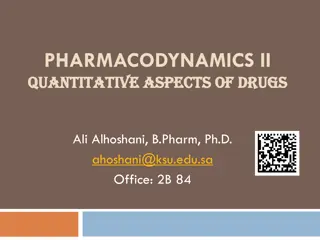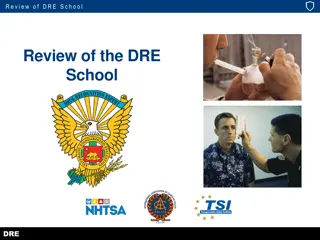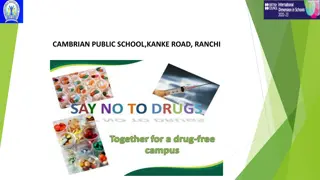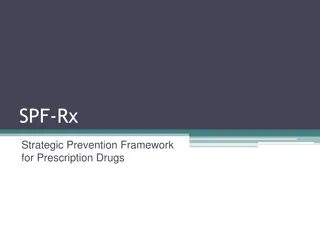Evaluation of National Drug Control Master Plan 2013-2017
An assessment conducted on the National Drug Control Master Plan and Action Plan for the years 2013-2017 highlighted the structural soundness of the strategy, focusing on goals, objectives, and action plans. The study also emphasized the importance of enhancing key strategic goals to better address drug-related harms and the shortcomings in budget allocation. Efforts to meet anticipated demands for both demand and supply reduction fell short, indicating room for improvement in resource allocation. Despite the identified shortcomings, the evaluation praised the plan's comprehensive approach, including elements such as management, prevention, treatment, supply reduction, and research.
Download Presentation

Please find below an Image/Link to download the presentation.
The content on the website is provided AS IS for your information and personal use only. It may not be sold, licensed, or shared on other websites without obtaining consent from the author.If you encounter any issues during the download, it is possible that the publisher has removed the file from their server.
You are allowed to download the files provided on this website for personal or commercial use, subject to the condition that they are used lawfully. All files are the property of their respective owners.
The content on the website is provided AS IS for your information and personal use only. It may not be sold, licensed, or shared on other websites without obtaining consent from the author.
E N D
Presentation Transcript
An Evaluation of the National Drug Control Master Plan and Action Plan: 2013 2017 John Carnevale, Ph.D. David Theiss, M.Sc. Carnevale Associates, LLC October 9, 2018
Our Approach Our methodology involved working along two dimensions: 1. Structural Matters: Looked at the strategic framework itself. This includes the flow among elements including Vision, Mission, Goals, Objectives, Action Plans, and Desired Outcomes. For example, was the Master Plan based on a comprehensive needs or situation assessment that involved input from stakeholders about problems needing to be addressed? Were action plans achieved? 2. Performance Success: In the end, the primary objective is to assess whether the Master Plan achieved intended results in other words, were the desirable results for reducing drug use and its consequences achieved. [2]
Structure of the Strategy We find the Master Plan to Be Structurally Sound: Vision and Mission Statements 1. Three goals supported by 18 objectives spanning demand reduction and supply reduction activities. 2. Supported by 59 action plans. 3. Action Plans are supported by a detailed projection of resource (budget) requirements to fund them. 4. All of this is based on a thorough Needs Assessment that includes fairly comprehensive data on drug use, consequences, and enforcement. [3]
Strengthen Key Strategic Goals There are 3 Strategic Goals: 1. To reduce drug-related harms by recognizing the drug problem as a major public health threat to the nation. To minimize the immediate concerns to the citizens in the context of the principal harms of drug use and abuse such as crime, public nuisance, drug-related violence, physical and mental health problems, social costs and community degradation. To respect human rights, local judicial norms, and cultural attitudes toward alcohol and drug use. 2. 3. These Goals could be made more direct, e.g., Goal 1 could be restated as follows: Reduce Drug-Related Harms We find Goal 2 to be amorphous; unclear--sounds like Goal 1 (reduce harms) We find Goal 3 to be more of a value statement rather than a Goal. [4]
Budget: But Demand does better than Supply Demand budgets fell short by an average of 30% of anticipated need; Supply budgets fell short by an average of 50% of anticipated need. [6]
Expected Success in Achieving Action Plans The Action Plan for Bermuda s Master Plan is divided into five sections: 1) Management and Coordination; 2) Prevention; 3) Treatment; 4) Supply reduction; and 5) Research, Evaluation and Policy. Bermuda s drug control plan has made significant inroads in each of these areas, but a large portion of the overall action plan remains incomplete. As of January 2018, 27 of the 59 (46 percent) action plan were incomplete. Nineteen action plan points are considered complete, 8 action points are classified as ongoing , and 5 action points are catalogued as partially complete . [7]
Finding with Regard to Overall Drug Use We find progress in reducing adult drug use over the period of the Master Plan this is the good news but also find that Bermuda s youth are using more drugs this is the bad news. While the progress achieved with adults is good news for the formulation of the next Master Plan, the news about Bermuda s youth should be a major cause for concern. [9]
Findings with Regard to Adult Drug Use There was a dramatic decline in the use of marijuana among adults. 20.2 percent of adults reported lifetime use of marijuana in 2017 compared with 37.0 percent in 2009. This change is also reflected in current use of marijuana; it was 4.8 percent in 2017 compared with 7.5 percent in 2009. Current use of Alcohol and tobacco is down as well. The use of cocaine, heroin, and hallucinogens continues to be a very small problem for adults. [10]
Change in Youth Drug Use: Concern about Current Marijuana Use [11]
Drug-related Health Consequences Continue to be a Small Problem There appears to be progress in reducing impaired driving, but it is not clear if this progress is real. DRUG-RELATED HEALTH CONSEQUENCES 2011-2016 What is unknown is whether this decline is due to a lower level of enforcement by law enforcement targeting impaired driving, or success in educating the public about the dangers of impaired driving. This issue clearly warrants further exploration by the DNDC. [12]
Increasing Drug Treatment Admissions Between 2012 and 2016, the number of individuals admitted to drug treatment at one of Bermuda s seven identified programs annually climbed from 93 to 152. During this five-year period, female treatment admissions doubled from 15 in 2012 to 31 in 2016. This jump represents a 107 percent increase in female treatment admissions. Male treatment admissions also increased during these years, jumping from 78 in 2012 to 121 in 2016. This represents a 55 percent increase in male treatment admissions. Female admissions increased modestly. In 2012, females accounted for 16 percent of all treatment admissions and 20 percent of admissions in 2016. [13]
Improvement (reduction) in crimes, drug possession, and importation of drugs Crimes reported against persons or the community declined DRUG-RELATED CRIME CONSEQUENCES 2012-2017 Crimes against property declined Drug offences for importation or local offenses also declined Substantial reduction in drug offenses, both local and importation offenses Drug Possession: The largest reported area of drug offenses in 2011 was for cannabis possession Drug seizures are also down over the period [14]
Our Six Major Recommendations (w/o detail) 1. Establish a National Centralized Coordinating Body that reports to Cabinet regularly on the progress in implementing the Master Plan. 2. Strengthen the DNDC s ability to manage the implementation of the Master Plan. 3. Require annual pubic progress reports for the Master Plan. 4. Improve the structure of the Master Plan by clarifying its strategic goals. 5. Continue to strengthen and expand the Drug Information Network to improve monitoring and evaluation. 6. Conduct ongoing research and evaluation of Bermuda s cannabis reform. [15]
Our Six Major Recommendations (with detail) 1. Establish a National Centralized Coordinating Body that reports to Cabinet regularly on the progress in implementing the Master Plan. a. Elevate the DNDC to a higher executive level policy office, independent of any Ministry. b. Require the DNDC to provide direct support to the National Centralized Coordinating Body. Strengthen the DNDC s ability to manage the implementation of the Master Plan. a. Designate an individual in each Ministry involved in drug control to report to the DNDC about budget, progress on action plans, and performance results. b. Expand external, private sector stakeholders to include the business community. Require annual pubic progress reports for the Master Plan. Improve the structure of the Master Plan by clarifying its strategic goals. Continue to strengthen and expand the Drug Information Network to improve monitoring and evaluation. a. Strengthen oversight of program and budgets of the supply reduction agencies. b. Include information showing progress in funding drug control activities against desired levels in the government s annual budget. Conduct ongoing research and evaluation of Bermuda s cannabis reform to include: a. Lessons learned from public health approaches implemented under cannabis reform, occurring in areas outside of Bermuda, to include effective prevention strategies and messaging. b. Special studies to better understand the epidemiology and trends in cannabis use, frequent use, and cannabis use disorder and its criteria (also called abuse, dependence, or addiction). c. Annual analyses of changes in incidence and prevalence of cannabis use and consequences such as impaired driving, psychological or medical consequences, and drug treatment needs. d. Effect of cannabis reform on tourism (e.g., drug tourism). 2. 3. 4. 5. 6. [16]
Conclusions Our evaluation of the National Drug Control Master Plan and Action Plan 2013 2017 (the Master Plan) finds that Bermuda did make progress in improving its drug situation. There were improvements in supply and demand outcomes, with the exception being youth drug use, particularly related to marijuana use. This area should be addressed in the next Master Plan, particularly in light of recent cannabis reform in Bermuda. Our six recommendations are intended to address structural matters related to how drug policy is managed (recommendations I, II, and III), provide greater clarity in the Master Plan s goals (recommendation IV), and to continue to expand knowledge of best practices from research/ data collection (recommendation V). We also recommend a new research focus on assessing the effect of cannabis reform in the wake of evidence what may be the start of a growing trend in drug use among Bermuda s youth (recommendation VI). [17]
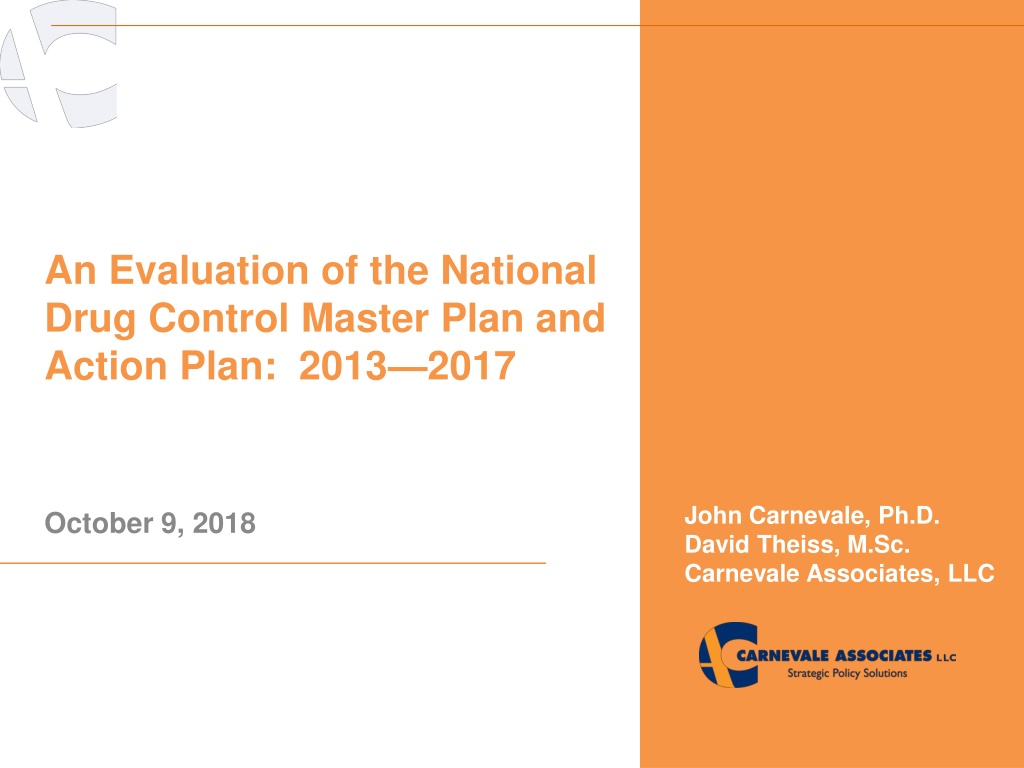
 undefined
undefined
















